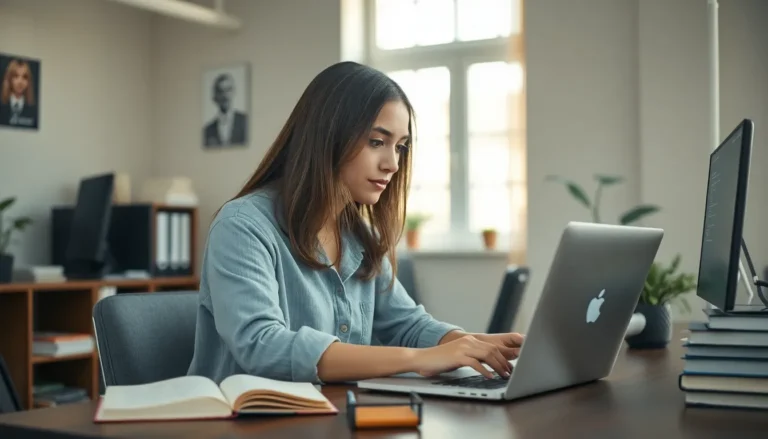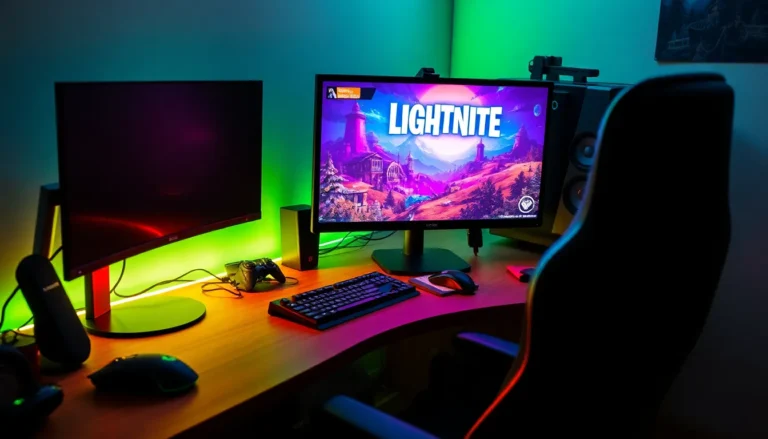Table of Contents
ToggleCapturing a screenshot on an iPhone might seem like a task only tech wizards can master, but it’s easier than finding your favorite cat meme online. Whether you want to save that hilarious group chat or snag a snapshot of your latest high score, knowing how to take a screenshot is a must-have skill in today’s digital world.
How To Take Screenshots On iPhone
Taking a screenshot on an iPhone is straightforward. Depending on the model, the method may vary slightly. For iPhones with Face ID, press the Side button and the Volume Up button simultaneously. Releasing both buttons captures the screen image instantly.
Models with a Home button follow a different approach. Press the Home button and the Side button at the same time, then release. This also takes a screenshot.
After capturing, a thumbnail appears in the corner, allowing users to edit or share directly. Tapping the thumbnail reveals options for drawing, adding text, or cropping. Users can swipe left to dismiss it without making changes.
Screenshots are saved automatically to the Photos app in the ‘Screenshots’ album, providing easy access later. Open the Photos app, navigate to Albums, and select ‘Screenshots’ to view captured images.
Another option involves using AssistiveTouch for those who prefer a touch-based method. By enabling AssistiveTouch in Accessibility settings, users can create a floating button on the screen. Tapping this button reveals a menu, where selecting ‘Device’ leads to the ‘More’ option. From there, choosing ‘Take Screenshot’ will capture the screen as well.
Sharing screenshots is easier than ever. Users can tap the share icon after capturing or within the Photos app. Options include messaging, emailing, or posting to social media. This accessibility enhances the ability to share memorable moments quickly, making screenshots a valuable tool for communication.
Methods For Capturing Screenshots
Capturing screenshots on an iPhone offers various methods to suit different user preferences and device styles.
Using Hardware Buttons
Users with iPhones featuring Face ID can easily take a screenshot by pressing the Side button and the Volume Up button simultaneously. The process is quick, with the screen flashing to confirm the action. For devices equipped with a Home button, pressing the Home button and the Side button together achieves the same result. This method consistently works across multiple apps and screens. After capturing, a thumbnail preview appears, allowing for immediate edits or sharing options.
Using AssistiveTouch
AssistiveTouch serves as an excellent alternative for taking screenshots without using physical buttons. Users must enable AssistiveTouch under Settings, then customize the menu to include the Screenshot option. Once added, tapping the AssistiveTouch icon on the screen presents the screenshot option instantly. This method works well for individuals who have difficulty pressing hardware buttons. Screenshots taken this way also generate a thumbnail for quick access to editing and sharing features.
Tips For Managing Screenshots
Screenshots can clutter an iPhone’s photo library if not managed effectively. Implementing a few organizational strategies helps keep the screenshot library tidy.
Organizing Your Screenshot Library
Creating albums specifically for screenshots offers instant access. Users can group similar screenshots, like travel plans or receipts, into dedicated folders. Deleting unwanted or duplicate images streamlines the library, ensuring only relevant content remains. Regularly reviewing the screenshots also prevents unnecessary accumulation. Using the built-in search feature in the Photos app speeds up finding specific screenshots based on dates or keywords.
Editing Screenshots After Capture
Editing screenshots directly after capture simplifies customization. Tapping on the thumbnail brings up editing tools like cropping, adding text, or marking up images with a pen. Adjusting colors and brightness enhances visibility for better sharing. Users can also utilize the eraser tool to remove unwanted annotations. Saving edited screenshots directly into the Photos app maintains all changes while keeping the original intact, ensuring flexibility for future use.
Common Issues And Solutions
Capturing screenshots on an iPhone can sometimes lead to issues. Users may struggle with not seeing the thumbnail after a screenshot is taken. Checking the settings in the Photos app can help ensure that thumbnails appear correctly.
Another common issue arises when users find screenshots blurry. Capturing images during moments of fast activity often leads to this problem. It’s advisable to wait for the screen to stabilize before taking a screenshot to enhance clarity.
Some individuals may accidentally take unwanted screenshots. This typically happens when buttons are pressed unintentionally while holding the device. Adjusting the grip on the iPhone can help prevent accidental captures.
Screenshots not saving is another challenge some users encounter. This often stems from lack of storage on the device. Users should check available storage in Settings under General and free up space if necessary.
Editing screenshots might be difficult for some users. When users forget to tap the thumbnail before it disappears, editing options become inaccessible. Waiting for the thumbnail to appear gives the opportunity to make necessary edits right away.
Users sometimes experience trouble sharing screenshots with friends. If users notice sharing options not appearing, it’s essential to check connection settings. Ensuring a stable internet connection can streamline the sharing process.
Accessing AssistiveTouch might also present hurdles. Some users may find enabling it tricky within the Settings menu. Navigating to Accessibility and toggling AssistiveTouch on can resolve this issue, providing a straightforward method for capturing screenshots.
Taking screenshots on an iPhone is an essential skill that enhances digital communication and helps capture important moments. With simple methods available for different iPhone models and the option to use AssistiveTouch, everyone can master this feature with ease.
Organizing and managing screenshots effectively keeps the photo library clutter-free. Regularly reviewing and creating dedicated albums can streamline access to important images. By following the tips provided, users can ensure they make the most of their screenshot capabilities while avoiding common pitfalls. Embracing this skill not only simplifies sharing but also enriches the overall iPhone experience.





